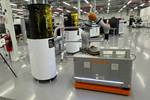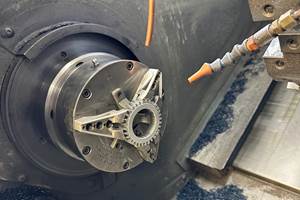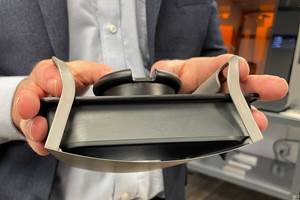Video: 3D Printed Tooling Eases Cobot Integration
At NPE 2024, Universal Robots and EMI Corporation highlighted how 3D printed end effectors, fixtures and more enable adoption of collaborative robots.
Collaborative robots or cobots are relatively simple to integrate into a manufacturing process. Unlike conventional robots, they do not require caging or complicated safety measures, and they are easy to program and reprogram as needs change. The challenge with integration today is not with the cobot itself, but with establishing the ways that it will interact with its surroundings. Hardware such as end effectors, grippers, part jigs and nests, and even cable management brackets can be custom-made to suit the application through 3D printing. At NPE: The Plastics Show 2024, Universal Robots and its partner EMI Corporation highlighted the value of 3D printed tooling with a booth demonstration incorporating multiple Multi Jet Fusion prints.
Related Resources
- More stories about robots and 3D printing
- A manufacturer with so much automation that it acquired a 3D printer just for its own cobot tooling needs
- How Ford is solving the integration problem to enable an AGV-mounted cobot to tend various 3D printers
- How plastics part producer Evco had to get creative to enable its cobot to manage a fleet of desktop printers
- More from NPE: The Plastics Show 2024
Transcript
00:00:00:00 - 00:00:08:19
Implementing collaborative robots or cobots can be an effective way for manufacturers to get started with automating tasks and reducing the physical workload on their employees.
00:00:08:19 - 00:00:16:01
But effectively integrating automation technology such as cobots often requires specialized hardware, and 3D printing can help.
00:00:16:01 - 00:00:26:00
I'm Stephanie Hendrixson with Additive Manufacturing Media, and at NPE: The Plastic Show 2024, I learned more about how 3D printing is assisting with robot and cobot integration.
00:00:26:00 - 00:00:35:19
At the event, I met with automation technology provider Universal Robots and their partner EMI Corporation, which provides robot grippers and other types of automation integration products.
00:00:35:22 - 00:00:56:06
What I learned is that it's relatively easy to incorporate a cobot into a workflow these days. These robots are relatively safe. They're easy to train. They're easy to move around the facility. But the difficulty comes from the way the cobot is going to interact with its surroundings. So how is it going to communicate with the different machines, and how is it going to interface with the parts that it needs to handle?
00:00:56:08 - 00:00:58:01
That's where 3D printing comes in.
00:00:58:05 - 00:01:08:12
At EMI, they 3D print many different automation products, including robot grippers and end effectors, part nests and fixtures, even things like cable management brackets.
00:01:08:21 - 00:01:32:08
In the Universal Robots booth at NPE they had this demo running. There was a Universal Robots cobot using a 3D printed vacuum gripper to lift a set of parts as if they had just been removed from an injection molding press, placed them into another 3D printed fixture designed to cut off the sprue material, and then lifted that set of parts again and placed down on a conveyor as if those parts were going on for additional processing.
00:01:32:10 - 00:01:36:07
All of the fixtures used in this demo were 3D printed by EMI.
00:01:36:11 - 00:01:53:00
The company routinely 3D prints tooling like this using Multi Jet Fusion, typically out of nylon. They also use TPU for parts that need to be handled delicately. Sometimes they’ll even thermoform a flexible material over the nylon to provide a nonmarring surface for handling parts like lenses.
00:01:53:00 - 00:01:59:12
EMI finds that 3D printing custom automation tooling like this is cost effective and keeps lead time short.
00:01:59:12 - 00:02:08:16
The polymer 3D printed tools are also lighter weight than they would be if they had to be machined out of steel or aluminum, which opens up more capacity for the parts that need to be handled.
00:02:08:16 - 00:02:16:02
If the cobot has to deal with a particularly heavy payload, every ounce counts, and it's important to get as much weight as possible out of the end effectors.
00:02:16:02 - 00:02:23:04
Using 3D printing to address custom tooling needs like this is not just a win for additive, it's also a win for automation.
00:02:23:04 - 00:02:34:08
Easier access to end effectors and other types of automation peripherals makes it faster, easier, and cheaper to integrate automation like this into facilities and into manufacturing processes.
00:02:34:08 - 00:02:47:13
For more about how 3D printing and automation goes together, see the links in the video description. And if you're interested in more ways that 3D printing is changing manufacturing, follow Additive Manufacturing Media. Thanks for watching.
Related Content
UltiMaker Targets Light Industrial Applications With 3D Printer Designed for the Factory Floor
The company’s Factor 4 3D printer introduced this week is designed to complement conventional manufacturing equipment including CNC machining and automation.
Read MoreChuck Jaws Achieve 77% Weight Reduction Through 3D Printing
Alpha Precision Group (APG) has developed an innovative workholding design for faster spindle speeds through sinter-based additive manufacturing.
Read MoreCopper, New Metal Printing Processes, Upgrades Based on Software and More from Formnext 2023: AM Radio #46
Formnext 2023 showed that additive manufacturing may be maturing, but it is certainly not stagnant. In this episode, we dive into observations around technology enhancements, new processes and materials, robots, sustainability and more trends from the show.
Read MoreFormlabs Part Removal Mechanism Enables Lights-Out Production
A build platform overcoming the need for manual part removal enables automated part handling, and therefore continuous production from one build cycle to the next.
Read MoreRead Next
Forerunner 3D Supports Automation with 3D Printed EOAT
The custom 3D printing company uses 3D printing in combination with other technologies to deliver end of arm tooling for part handling.
Read MoreAutonomous Cobot Automation Increases Production 3D Printer Output for Ford (Includes Video)
A mobile robot that travels to each Carbon machine to unload builds lets the automaker run an additional three to four builds per machine per day. Autonomous robots fit well with 3D printing, but their role in production will extend beyond just the additive machines.
Read MoreCrushable Lattices: The Lightweight Structures That Will Protect an Interplanetary Payload
NASA uses laser powder bed fusion plus chemical etching to create the lattice forms engineered to keep Mars rocks safe during a crash landing on Earth.
Read More
.jpg;width=70;height=70;mode=crop)



















